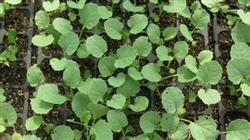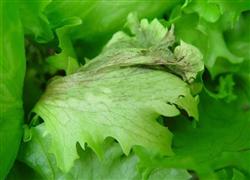How to raise seedlings of broccoli (broccoli)?

How to raise seedlings of broccoli (broccoli)? Please introduce that broccoli is the main vegetable export crop in Zhejiang Province. the perennial planting area of broccoli is about 10,000 hectares, but because the sowing season of broccoli is in the period of high temperature and typhoon activity from July to September, how to make full use of the limited growing season to cultivate strong seedlings has become the key to broccoli production, processing and export trade. In line with the purpose of tackling key technical problems and serving around the leading industry, Xiangshan Modern Agricultural Experimental Field successfully cultivated 140 hectares of broccoli seedlings from 2001 to 2002, which effectively solved the problem of seedlings for production. The environmental requirements for the growth and development of broccoli seedlings include three stages: germination period, basic vegetative growth period and rapid seedling growth period. Broccoli is a semi-cold-tolerant vegetable. The lowest temperature for germination is 3 ℃, the optimum temperature is 20: 25 ℃, the highest temperature is 35 ℃, and the suitable temperature for plant growth is 20: 22 ℃. The corm will suffer frost injury at the low temperature of-5 ℃. The requirement of low temperature for flower bud differentiation is not strict. Early maturing varieties can differentiate through flower bud as long as the average temperature is below 20 ℃, but they will form small florets at low temperature at seedling stage, which will lose their commodity and reduce yield, and the temperature below 8 ℃ will grow slowly. The flower bud differentiation of middle and late mature varieties requires a low temperature, so it can not be cultivated in the high temperature season, otherwise it will form leaf cuttings, hairy flower heads and burnt buds. Therefore, broccoli has strict requirements on sowing date. Broccoli requires sufficient light, but it is not strict about the length of sunshine. Its nature likes wetting, but it is not resistant to drought and waterlogging, and has strict requirements for water, especially in the seedling stage, drought and waterlogging prevention is the focus of seedling stage management. It is required that the soil of the seedbed is loose, fertile and has good water retention and permeability. Second, the seedling raising method of broccoli is related to its variety characteristics and stubble arrangement. The eastern coast of Zhejiang Province generally uses open-field sowing plus sunshade net to cover temperature and agricultural film to cover rain-proof seedlings. Third, the standard seedling age of strong seedlings is 30-35 days, and the leaf age is 5-6 true leaves, with strong growth, no diseases and insect pests, stout stems, short internodes, large and thick leaves, normal leaf color, well-developed root system, well-developed fibrous roots, and neat plant growth. Fourth, seedbed preparation 1. The selection of broccoli seedlings should choose the fields with high dry terrain, good drainage, ventilation and light, loose soil rich in organic matter, and fields that have not been planted cruciferous vegetables in the past two years. To raise seedlings, it is required to keep enough seedbeds at 1:20. The seedbed was ploughed and turned over the soil one week before sowing, the high efficiency compound fertilizer 25kg was applied every 667m2, and the whole layer was applied deeply; the seedbed was 2m wide, 40~50cm wide, high 15~20cm, deep ditch high; the seedbed finishing was required to be thick and loose, and the border surface was fine, flat and smooth. two。 Nursery bed disinfection export broccoli seedlings should strictly follow the national rules for pollution-free production of vegetables, seedbed disinfection choose 25% Redomir 500 times solution plus 40.7% Lesbon 800 times liquid sowing before spraying the seedbed to sterilize and kill underground pests. 3. Chemical weeding before sowing can reduce the damage of weeds during seedling cultivation and reduce the production cost of seedlings. Duer, a dry land herbicide with good safety and broad herbicide spectrum, can be used to spray the border surface with 70% EC 20mL and water 15kg before sowing and water the seedling bed. 4. Pre-sowing soil moisture control broccoli seedlings in the completion of the above work, we must adjust the seedbed soil moisture, too little soil moisture, affecting seed sprouting; too high humidity will cause soil airtight rotten seeds. Therefore, the principle of water control before broccoli sowing is that the surface of the border is wet and the furrow is permeable, which can not only reduce the porosity between the soil and prevent the seed from sinking and affecting the emergence of broccoli, but also the practice has proved that the degree of soil dryness and humidity is directly related to the quality of seedling emergence. Fifth, sow seeds. The main basis for determining a reasonable sowing date is the characteristics of varieties, weather conditions and cultivation purposes. The sowing time of extra-precocious varieties such as Lvfeng and Qingfeng cultivated along the eastern coast of Zhejiang Province is from mid-July to mid-August, and that of early-maturing varieties such as excellent varieties is early and mid-August. The sowing date of middle-maturing varieties such as green belt and marathon is from late August to early September, and the sowing date of late-maturing varieties such as Rumei Lu90 and Fuxing is from mid-September to early October. two。 To determine the reasonable sowing rate, the seeds of broccoli are fine. in order to ensure the number of seedlings used in the field and make the seedlings have sufficient growth space, the amount of seeds in the field must be calculated scientifically. The calculation formula is as follows: seed dosage (667 square meters) = [number of seedlings / 667 square meters × (1 + safety factor)] × 1000-grain weight / germination rate. The germination rate of qualified seeds is more than 85%, and the safety factor of seedlings is 80%. At present, the 1000-grain weight of the main varieties is 3.17g, 3.6g, 5.56g, 2.96g and 3.94g, respectively. It is calculated that the amount of seed used in the field of 667 square meters is excellent 12g, green belt 15g, plum green 90 20g, super force 12g, Fuxing 15g. 3. Sowing and sowing must be uniform, and the method of fine sediment mixed with dry seed direct seeding is often used to sow broccoli seeds evenly on the arranged seedbed. The sowing time should be sunny evening or cloudy day. Generally, broccoli seeds should not be covered with fine soil after sowing, but should be closely contacted with fine sprinkler after sowing, and then covered with 2-3 layers of sunshade net to cool and moisturize the border. 6. Seedbed management 1. The management of broccoli sprouting at seedling stage takes 2-3 days and nights from sowing to seedling emergence, and the time is short, but the management requirement is high, so we should strengthen the observation. Starting from the overall environmental conditions at the seedling stage, we should pay attention to the regulation of temperature and moisture. The whole germination period must be observed in the field three times a day in the morning, afternoon and evening to observe the seed germination, the dryness and humidity of the border soil, the intensity of sunshine or the field drainage on rainy days. Under the condition of sunny day and high temperature from July to September, the germination and seedling stage mainly depends on watering to adjust the soil temperature to keep the soil temperature at the suitable temperature of 2530 ℃ to facilitate normal seedling emergence. Watering can be carried out before noon and in the evening to avoid overcast and rainy weather after watering. During this period, the border was covered with a sunshade net for 2-3 days and nights to cool down and prevent rain. When the two cotyledons turned green after emergence, the sunshade net was removed in time. two。 The management of the basic vegetative stage of the seedling the cotyledon turning green to the 2-leaf and 1-core stage is the basic nutritional stage of broccoli seedlings, and the cotyledons of broccoli seedlings expand and turn green and enter an independent autotrophic stage, if the root growth and absorption is poor, or the temperature in the seedling bed is too high, it is easy to cause poor growth and development of seedlings. With the growth and expansion of true leaves and the expansion of leaf area, the function of cotyledons gradually lost after 2 leaves and 1 heart stage. The management of this period is the key to the cultivation of strong seedlings. In management, we should mainly do a good job in these aspects: first, set up a small arch shed and cover the sunshade net in time. Cover the sunny day from 8 am to 4 pm to cool down, remove the sunshade net the rest of the time, do not cover the net in cloudy days and light rain, and cover the net intermittently for 1 week. The second is to strengthen water management. Clear the ditch and drain in time after rain to ensure that there is no stagnant water in the field; on a sunny day, the soil surface is watered in time to preserve soil moisture. The third is to prevent typhoons and rainstorms. Pay close attention to the forecast of typhoon, rainstorm and other bad weather, take various disaster prevention measures before typhoon and rainstorm, cover the agricultural film on the small arch shed, roll up the agricultural film every 2m to form a vent for ventilation and reduce humidity, press the film with the pile head between every two arch bars, cover the sunshade net on the top of the agricultural film and tighten it with nylon rope or pressing film line with the pile head. Facilities such as agricultural film and sunshade net should be removed in time after typhoon and rainstorm to prevent seedlings from overgrowing. Fourth, strengthen the prevention of diseases and insect pests. From emergence to 1 leaf and 1 heart stage, use 40.7% Lesben 800-fold solution plus 3% Jinggangmycin 500-fold solution to prevent ape leaf insect damage and prevent the occurrence of blight and sudden fall disease. In 2 leaves and 1 heart stage, 75% chlorothalonil 1000 times solution and 3% Jinggangmycin 500 times solution were used to prevent bacterial blight and sudden collapse. 3. Rapid seedling growth period Management seedlings enter the rapid growth period after the 2-leaf and 1-heart stage, and 90% of the seedling growth is formed during this period. At this time, the temperature is still high, and the root system forms and grows very fast. in order to cultivate strong seedlings, the management of this period should be mainly controlled. In terms of management, we should mainly do a good job in these aspects: first, we should continue to do a good job in preventing typhoons and rainstorms, with reference to the basic vegetative growth period of seedlings. The second is to continue to do a good job of water management that can see dry and wet, preferring dry to wet. The third is to do a good job in the inter-seedling work at the two-leaf and one-heart stage, so that the growth space of seedlings in the seedling bed can reach a uniform level of 10 square centimeters per plant, and ensure that the number of seedlings of 667 square meters will reach 50,000. Fourth, fertilization is controlled during the whole seedling growth period, but a small amount of urea can be applied to weak seedlings to promote balance. Fifth, to strengthen the prevention and control of insect pests, 5% fipronil 1500 times solution can be used to control Plutella xylostella, Pieris rapae and Chilo suppressalis, 20% rice full 1000 times solution plus 10% cypermethrin 1500 times solution to control beet armyworm and Spodoptera litura. 10% imidacloprid 3000 times solution was used to control aphids. 7. Seedling emergence and management after the management of the above series of measures, the seedlings must be out of the nursery and planted into the field in time when they have 5 or 6 leaves. Two days before transplanting, a small amount of urea was used to apply start-up fertilizer, check and control diseases and insect pests, and transplant strong seedlings with fertilizer and mud. When raising seedlings, the nursery was watered to prevent root damage, and large seedlings with consistent growth were selected to come out of the nursery. Water the seedlings in time after pulling out the seedlings to facilitate the growth and development of the seedlings, and the seedlings will come out of the nursery after being cultivated for one week. Click to get more cauliflower planting techniques click to get more vegetable planting techniques
- Prev

How to prevent and cure lettuce brown spot?
How to prevent and cure lettuce brown spot? Please introduce the control methods of lettuce brown spot mainly harms the leaves, generally through seed disease and wind and rain transmission, spread, infection, poor plant growth or partial application of nitrogen fertilizer will lead to the aggravation of the disease. There are two symptoms of the disease: one is the initial appearance of waterlogging.
- Next

What causes the quality deterioration of summer cauliflower?
What causes the deterioration of summer cauliflower quality? Please introduce the quality of cauliflower in summer production, often due to the influence of environmental conditions and improper cultivation measures. In many years of planting cauliflower, we have accumulated some experience in preventing the deterioration of common cauliflower quality, which is now introduced to you for reference. ...
Related
- Where is it suitable to grow horseradish in China? it is expected to see the middle altitude horseradish in Alishan.
- How to prevent tomato virus disease reasonably? (Control methods included)
- Many people like to plant towel gourd on the balcony. What are the main points of this method and management?
- What crops can chili peppers be mixed with?
- Fertilization techniques and matters needing attention in Tomato
- What are the grafting techniques for peach seedlings in spring?
- Harm and control methods of root swelling disease of Chinese cabbage
- What are the pests of sweet potatoes? How to prevent and cure it?
- Symptoms, causes and Control methods of navel Rot in Tomato
- The cause of "Cucumber rotten bibcock" in Farmers' planting Cucumber and its Control Plan

